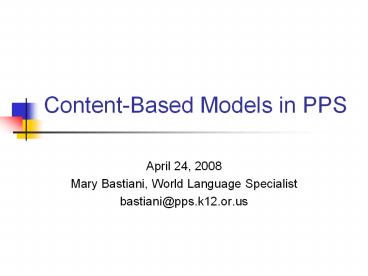Content-Based Models in PPS - PowerPoint PPT Presentation
Title:
Content-Based Models in PPS
Description:
Instructional Goals ACTFL Advanced Level ... Building background knowledge 2) Using Learning Phases 3) Integrating Modalities 4) Using Scaffolding Techniques 5 ... – PowerPoint PPT presentation
Number of Views:124
Avg rating:3.0/5.0
Title: Content-Based Models in PPS
1
Content-Based Models in PPS
- April 24, 2008
- Mary Bastiani, World Language Specialist
- bastiani_at_pps.k12.or.us
2
- A focus on content-based instruction, a
contextualized, input-rich learning environment,
and the integration of culture throughout the
curriculum will be required to create a setting
in which learners can attain the desired advanced
linguistic and cultural proficiency levels. - Texas Language Roadmap, 2007
3
Early Start
- children who are exposed to another language
from the earliest stage of learning are more
likely to attain advanced proficiency levels. - Omaggio, 1993
4
Heritage Speakers
- Developing advanced language skills also means
taking advantage of the linguistic abilities
already obtained by heritage speakers who are
often considered disadvantaged learners.
5
Instructional Goals
- ACTFL Advanced Level Proficiency upon graduation
- Demonstrated Knowledge Skills in content areas
equal to or better than monolingual peers
6
What is CBI
- Many Definitions.
- Commonly used to describe approaches to
integrating language and content instruction, but
it is not always used in the same way.
7
Crandall Tucker (1990)
- an approach to language instruction that
integrates the presentation of topics or tasks
from subject matter classes (e.g., math, social
studies) within the context of teaching a second
or foreign language.
8
Curtain Dahlberg
- curriculum concepts being taught through the
foreign language appropriate to the grade level
of the students
9
Definition of Content
- academic subject matter (Crandall Tucker)
- need not be academic it can include any topic,
theme or non-language issue of interest or
importance to the learners (Genesee)
10
Program Models
- Immersion
- Partial Immersion
- Dual Language (Two-Way)
- Content-Based FLES
- Content-Enriched FLES
- Sequential FLES
- Content Courses (Chemistry in Mandarin)
11
Foreign Language in the Elementary School
(FLES)(Lipton)
FLES
FLEX (Exploratory) SEQUENTIAL FLES CONTENT-ENRICHE
D FLES
CONTENT-BASED FLES IMMERSION (total/partial/two-wa
y)
12
FLEX (Exposure/Exploratory)
- Introduction to a foreign language culture
- Used to motivate students to pursue language
study - Proficiency in the language is not an objective
- Quite often conducted in English
13
Sequential FLES
- Primary stress is on understanding speaking
- Articulates from grade level to grade level
- Proficiency IS an objective
- Classes range from 2 to 5 times per week
- Classes range from 15 to 60 mins/day
- 75 minutes per week minimum
14
Content-Enriched FLES
- Similar to Sequential FLES except that
- Subject content from the school curriculum is
reinforced through the foreign language - Content learning is integrated with language
development (i.e., key concepts from social
studies, math, science, health..) - Teacher does not have full responsibility of the
content - Because of the focus on the content, students
proficiency gains are usually higher
15
Content-Based FLES
- Similar to Content-Riched FLES except that
- Subject content is taught through the foreign
language - Content learning is integrated with language
development (i.e., social studies, math, science,
health, etc.) - Teacher has full responsibility for the content
acquisition - Students tend to make greater proficiency gains
16
Immersion (total/partial/2-way)
- 4 or more hrs. taught in the L2/day
- Content-based
- Articulates grade level by grade level
- Variety of program models
- Proficiency gains tend to be higher then
sequential or content-enriched/based FLES - Outcome includes content mastery
17
Characteristics of CBI (Met, 1999)
- Content-Driven
- Content is taught in L2
- Content learning is priority
- Language learning is secondary
- Content objectives determined by course goals
- Students evaluated on content mastery
- Language-Driven
- Content is used to learn L2
- Language learning is priority
- Content learning is incidental
- Language objectives determined by L2 course goals
or curriculum. - Students evaluated on language skills/proficiency
18
Program Continuum (Met 1999)
Content-Driven
Language-Driven
- FL
- Content
- Courses
Sheltered Courses
Content Theme-Based Courses
Content-related Language Classes
Immersion Dual Language
Content-enriched FLES
Business Spanish
19
Underlying Principles
- Fred Genesee article
- Myriam (MiMi) Met article
20
Lessons from Immersion
- Fred Genesee article.
- Reviews research from the field of immersion
education and identifies important lessons that
can be learned from this CBI model.
21
Expert Read
- Read the question and section that has been given
to you - You have 10 minutes to read and summarize your
section - As you read, underline key sentences, phrases,
words - Report out
22
Curriculum Considerations
- Content Objectives
- Functional Language Objectives
- Culture Objectives
- Instructional Strategies
- Assessment
23
CAPRII Key Concepts
- Diane Tedick article
- Read the section.
- Underline key sentences, phrases, words, etc.
that stand out for you - Report out
24
10 Core Instructional Strategies
- 1) Building background knowledge
- 2) Using Learning Phases
- 3) Integrating Modalities
- 4) Using Scaffolding Techniques
- 5) Using Graphic Organizers
- 6) Contextualizing Grammar
- 7) Providing Meaningful Input
- 8) Maximizing output
- 9) Giving/Receiving Feedback
- 10) Using Learning Strategies
25
Scaffolding Techniques
- In pairs, review the materials for Using
Scaffolding Techniques - Choose either Verbal Procedural or an
Instructional techniques/tools - Develop one sample activity that you will model
for the group
26
Resources
- Center for Advanced Research on Language
Acquisition (CARLA) - http//www.carla.umn.edu
- Content-Based Language Teaching with Technology
(CoBaLTT) - http//www.carla.umn.edu/cobaltt/index.html































